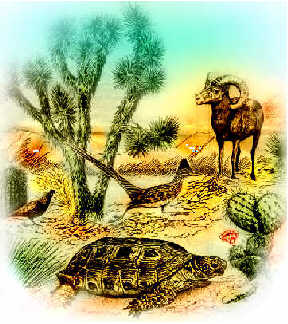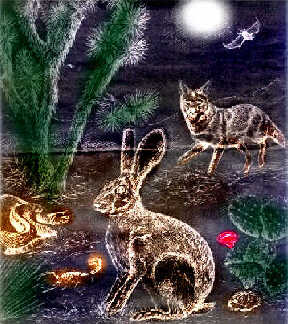A Living Desert


At a first glance the desert seems to be hot and barren with no life at all,
however a closer look will reveal nature’s wonders at their best.
There are many different kinds of plants, animals, insects and reptiles that
the desert is home to.
The desert is a fragile area. The animals and plants depend on each other
and their surroundings for survival. many animals need plants for food,
homes, shelter and shade. Many plants need insects, birds and other animals
to pollinate their flowers, spread their seeds or keep their neighbors from
growing too big. kangaroo rats and other animals that eat seeds depend on
the insects that pollinate flowers so they can make seeds. Even the
mammals, reptiles, and birds that eat insects and other small animals depend
on the plants that the smaller creatures eat. Some animals only eat certain
kinds of plants. Other animals may eat only certain parts of plants.

The ground is important also. many desert plants can only grow if the soil is
just the right kind and the right depth. Rocks, cliffs and dry washes give
shade and protection for plants and animals. Some plants can grow only in
the shade of a larger plant. Some plants need open spaces away from other
plants that compete for water and sunlight. Even bacteria and fungus are
important. These decompose dead plants and animals and return nutrients to
the soil. This helps other things grow.

So you can see that nearly every living thing in the desert depends on
something else to survive. Even a small change in the desert can harm many
different plants and animals. Nature sometimes changes the environment
quickly with great storms, earthquakes or landslides. Usually, nature makes
very small changes over a long time and plants and animals are able to adapt
or change in order to survive.
Place cursor on picture for diagram

Barrel cactus -fig.1 Gambel's quail -fig. 2 Desert tortoise -fig.3
Western fence lizard -fig.4 Pricly pear cactus -fig.5 Mojave yucca -fig.6
Desert bighorn -fig.7 Roadrunner -fig.8 Joshua tree -fig.9
Night Time In The Desert
Place cursor on picture for diagram

Barrel cactus-fig.1 Sidewinder-fig.2 Scorpion-fig.3
Jackrabbit-fig.4 Kangaroo rat-fig.5 Prickly pear cactus-fig.6
Mojave yucca-fig.7 Coyote-fig.8 Bat-fig.9 Joshua tree-fig.10
Cactus
The Barrel Cactus and The Prickly Pear Cactus
 ~
~ 
The Barrel Cactus~Perhaps the most recognized cactus in the desert is teh barrel cactus. It is not hollow as many belive, but has a spongy pulp inside. When growing, most barrel cactus lean toward the south. It is also known as the bisnaga, red barrel, fire barrel, solitary barrel and compass barrel cactus. The barrel cactus has been used by the Indians as a source of water.
The Prickly Pear Cactus~There are many types of prickly pear cactus. Most can be recognized by flattened stems, called pads, that grow from joints. Indians would carefully scrape or burn off the spines and cook the pads for food. The egg-shaped fruits called "tunas", can still be found in some grocery stores. The beavertail cactus looks like the pricly pear but does not have long spines, it has tiny hair-like spines instead. The prickly pear cactus is also use to make a type of desert candy.
The Strawberry Hedgehog Cactus

The Strawberry Hedgehog Cactus~This plant is also called the calico cactus because of the different colored bands on its spines. The Strawberry Hedgehog grows with a cluster of cucumber-shaped stems. It's bright pink flowers produce a fruit that tastes like strawberries.
Desert Plants
The Joshua Tree

The Joshua Tree~ This plant is found only in the Mojave Desert. It is not really a tree because there is no wood in it. To conserve energy the Joshua tree does not bloom every year. It waits until conditions are right. Water is stored n its thick, spongy "trunk". Indians used many parts of the Joshua tree.
The Mesquite Tree

The Mesquite Tree~ The Mesquite tree is one of the most common desert trees. It usually grows along washes or dry stream beds. The mesquite has large, straight thorns on its branches. This tree's seed pods look like string beans. The pods are sweet and are eaten by many animals. The pods turn hard and yellowish when dry. The Indians ate the pods, and used the sap as candy, glue and black dye.
Indian Rice Grass

Indian Rice Grass ~This feathery-bunched grass was a food staple for the Indians who made flour from the seeds.
Creosote

Creosote~ This large shrub has small round leaves which look and feel oily or sticky. This coating is called lac and helps to keep water from being lost to the dry air. Indians used lac as glue.
Living Desert Continued
cafe

Back to YV Wi


